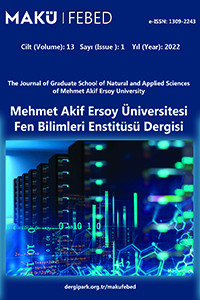Miselyum Kompozitlerinin Sürdürülebilir Yapı Malzemesi Olarak Kullanımı
Biyokompozit, mantar, miselyum, sürdürülebilirlik, yenilenebilir kaynaklar
Use of Mycelium Composits as Sustainable Structure Materials
Biocomposite, fungi, mycelium, sustainability, renewable resources,
___
- Alemu, D., Tafesse, M, Mondal, A. K. (2022). Mycelium-based composite: The future sustainable biomaterial. International Journal of Biomaterials, 2022; DOI: 10.1155/2022/8401528
- Aparna, D., Anuja, K., Joe, R (2019). Effect of mycelium on self-healing bioconcrete. Bridge Engineering Institute Conference (BEI), 22-25 July 2019, Honolulu, Hawaii, USA: 218-222.
- Bitting, S., Derme, T., Lee, J., Van Mele, T., Dillenburger, B., Block, P. (2022). Challenges and Opportunities in Scaling up Architectural Applications of Mycelium-Based Materials with Digital Fabrica-tion. Biomimetics, 7(2), 44; DOI: 10.3390/biomimetics7020044
- Barreca, F., Fichera, C. R. (2016). Thermal insulation performance assessment of agglomerated cork boards. Wood and Fiber Science, 48(2): 96-103.
- Dias, P. P., Jayasinghe, L. B., Waldmann, D. (2021). Investigation of Mycelium-Miscanthus composites as building insulation material. Results in Materials, 10; DOI: 10.1016/j.rinma.2021.100189
- Elsacker, E., Vandelook, S., Van Wylick, A., Ruytinx, J., De Laet, L., Peeters, E. (2020). A comprehensive framework for the production of mycelium-based ligno-cellulosic composites. Science of The Total Environment, 725, 138431; DOI: 10.1016/j.scitotenv.2020.138431
- Gil, L. (2009). Cork composites: A review. Materials, 2(3): 776-789.
- Gil, L. (2015). New cork-based materials and applications. Materials, 8(2): 625-637.
- Gou, L., Li, S., Yin, J., Li, T., Liu, X. (2021). Morphological and physico-mechanical properties of mycelium biocomposites with natural reinforcement particles. Construction and Building Materials, 304: 124656; DOI 10.1016/j.conbuildmat.2021.124656
- Islam, M. R., Tudryn, G., Bucinell, R., Schadler, L., Picu, R. C. (2017). Morphology and mechanics of fungal mycelium. Scientific reports, 7(1): 1-12; DOI: 10.1038/s41598-017-13295-2
- Jones, M., Bhat, T., Wang, C. H., Moinuddin, K., John, S. (2017, August). Thermal degradation and fire reaction properties of mycelium composites. In Proceedings of the 21st International Conference on Composite Mate-rials, Xi’an, China, 20-25.
- Jones, M., Mautner, A., Luenco, S., Bismarck, A., John, S. (2020). Engineered mycelium composite construction materials from fungal biorefineries: A critical review. Materials & Design, 187: 108397; DOI: 10.1016/j.matdes.2019.108397
- Malanho, S., Veiga, R., & Farinha, C. B. (2021). Global performance of sustainable thermal insulating systems with cork for building facades. Buildings, 11(3): 83; DOI: 10.3390/buildings11030083
- Manan, S., Ullah, M. W., Ul-Islam, M., Atta, O. M., Yang, G. (2021). Synthesis and applications of fungal mycelium-based advanced functional materials. Journal of Bioresources and Bioproducts, 6(1): 1-10; DOI: 10.1016/j.jobab.2021.01.001
- Özlü, D., Nicholas, P. (2021). Architecture of reforestation: Mycelium as a new building material and design of the fibrous woven scaffolds. 12-15 October 2021, Coimbra, Portugal.
- Özdemir, E., Saeidi, N., Javadian, A., Rossi, A., Nolte, N., Ren, S., Dwan, A., Acosta, I., Hebel, D.E., Wurm, J., Eversmann, P. (2022). Wood-veneer-reinforced mycelium composites for sustainable building compo-nents. Biomimetics, 7(2): 39; DOI 10.3390/biomimetics7020039
- Robertson, O. (2020). Fungal future: A review of mycelium biocomposites as an ecological alternative insulation material. DS 101: Proceedings of NordDesign 2020, Lyngby, Denmark, 12th-14th August 2020, 1-13.
- Saez, D., Grizmann, D., Trautz, M., Werner, A. (2020). Analyzing a fungal mycelium and chipped wood composite for use in construction. In Proceedings of the IASS Annual Symposium 21: 555-565.
- Soh, E., Chew, Z. Y., Saeidi, N., Javadian, A., Hebel, D., Le Ferrand, H. (2020). Development of an extrudable paste to build mycelium-bound composites. Materials & Design, 195: 109058; DOI: 10.1016/j.matdes.2020.109058
- Silvestre, J. D., Pargana, N., De Brito, J., Pinheiro, M. D., Durão, V. (2016). Insulation cork boards- environmental life cycle assessment of an organic construction material. Materials, 9(5): 394; DOI: 10.3390/ma9050394
- URL-1 (2022). https://www.fikir.gen.tr/mantarlar-alemi-ve-ozellikleri-mantarlarin-biyolojik-ve-ekonomik-acidan-onemi/ (Erişim Tarihi: 21.05.2022)
- van Nieuwenhuizen, J. D. C., Blauwhoff, D. R. L. M., De Werdt, M. F. C., Van Der Zanden, W. G. N., Van Rhee, D. J. J. L., Bottger, W. O. J. (2017). The compressive strength of mycelium derived from a mushroom production process. Academic Journal of Civil Engineering, 35(2): 265-271.
- Vandelook, S., Elsacker, E., Van Wylick, A., De Laet, L., Peeters, E. (2021). Current state and future prospects of pure mycelium materials. Fungal biology and biotechnology, 8(1): 1-10; DOI: 10.1186/s40694-021-00128-1
- Yang, L., Park, D., Qin, Z. (2021). Material function of my-celium-based bio-composite: A review. Frontiersin material, 374; DOI: 10.3389/fmats.2021.737377
- Yayın Aralığı: Yılda 2 Sayı
- Başlangıç: 2010
- Yayıncı: Burdur Mehmet Akif Ersoy Üniversitesi
Çanakkale Merkez İlçedeki Bazı Parkların Kent Mobilyaları Açısından Değerlendirilmesi
Miselyum Kompozitlerinin Sürdürülebilir Yapı Malzemesi Olarak Kullanımı
Esra SARİAY, Ahmet CÖRÜT, Banu Yeşim BÜYÜKAKINCI
Isparta’da Doğal Olarak Yetişen Tıbbi ve Aromatik Bitkilerle Oluşturulan Bir Şifa Bahçesi Örneği
Beste KARA, Şirin DÖNMEZ, Emine ŞİMŞEK
Domateste Kitosan ve Bazı Uçucu Yağ Kombinasyonlarının Kök Ur Nematodu Üzerindeki Etkinliği
Fatma Gül GÖZE ÖZDEMİR, Hacer ÇEVİK, Jean Claude NDAYIRAGIJE, Tuğçe ÖZEK, İsmail KARACA
Hastane İç Mekânlarında Yaşlılar için Renk Kullanımı
Makbule Berfin BÜKER, Zuhal KAYNAKCI ELİNÇ
Kentsel Koruma Politikalarının Uygulama Bağlamında Değerlendirilmesi: Uşak Kentsel Sit Alanı Örneği
Engelli Bireylerin Denizli-Pamukkale'deki Kentsel Dış Mekânlara Erişebilirliğinin İncelenmesi
Selçuk FİLİZ, Ali Kemal BİRGÜCÜ, Alime BAYINDIR EROL
Kayseri Kenti için Olasılıksal Sismik Tehlikenin Değerlendirilmesi
